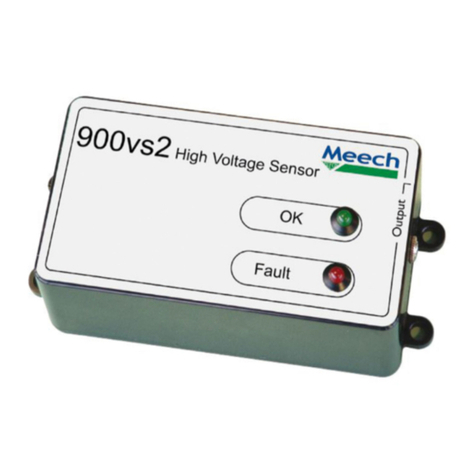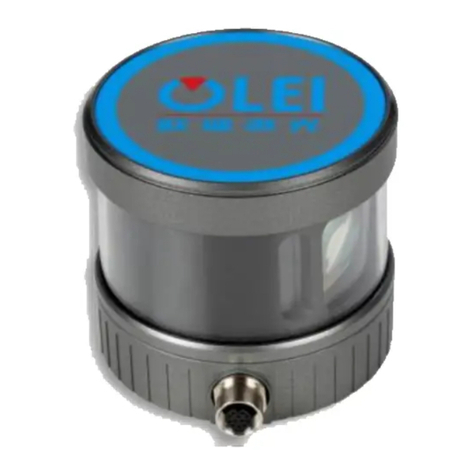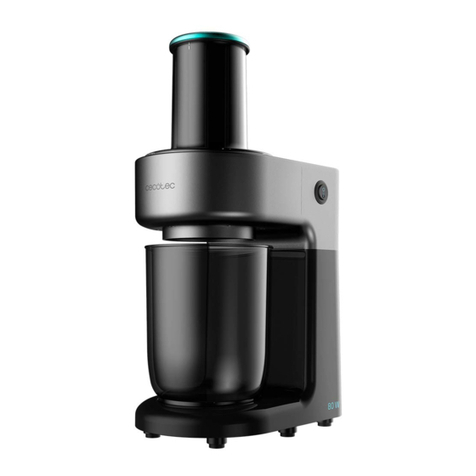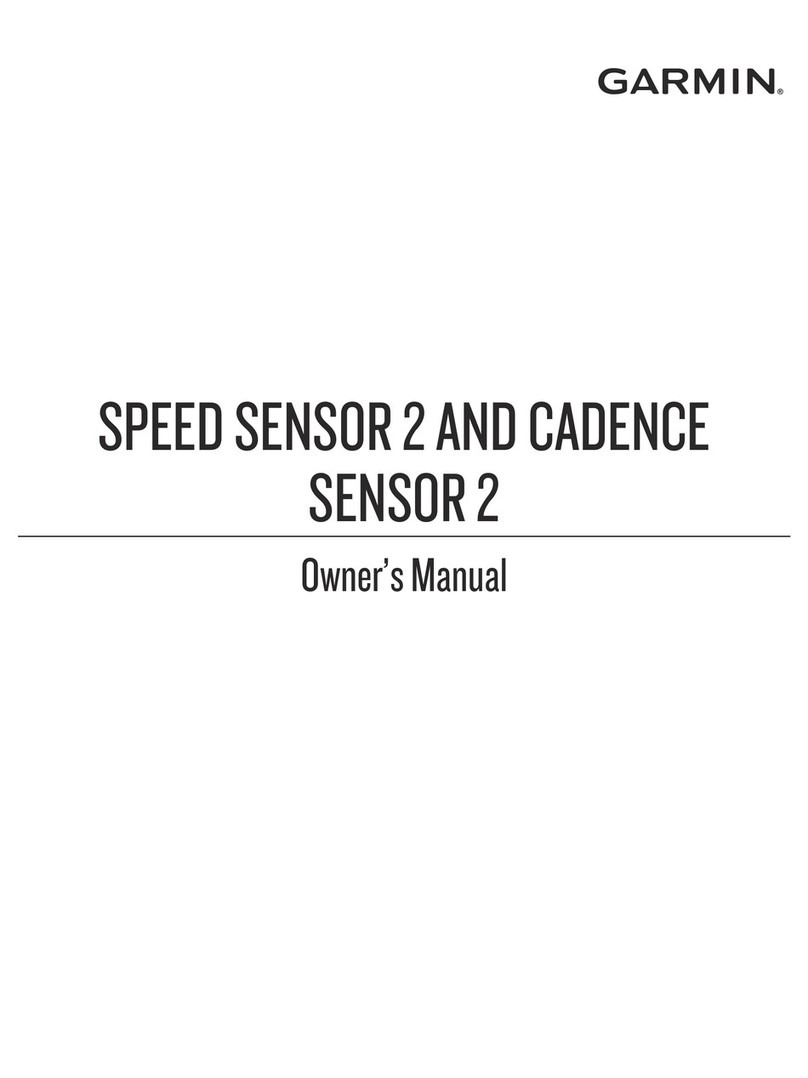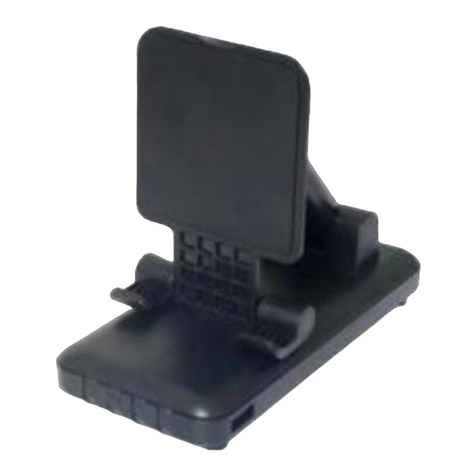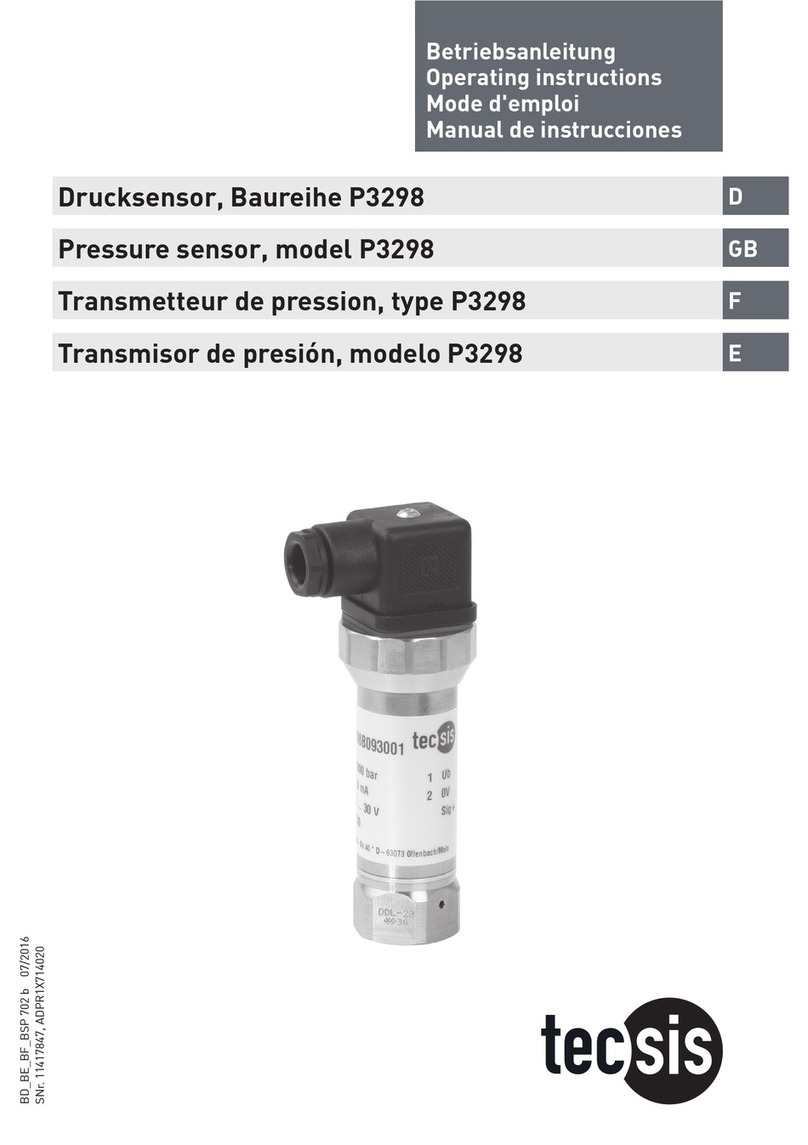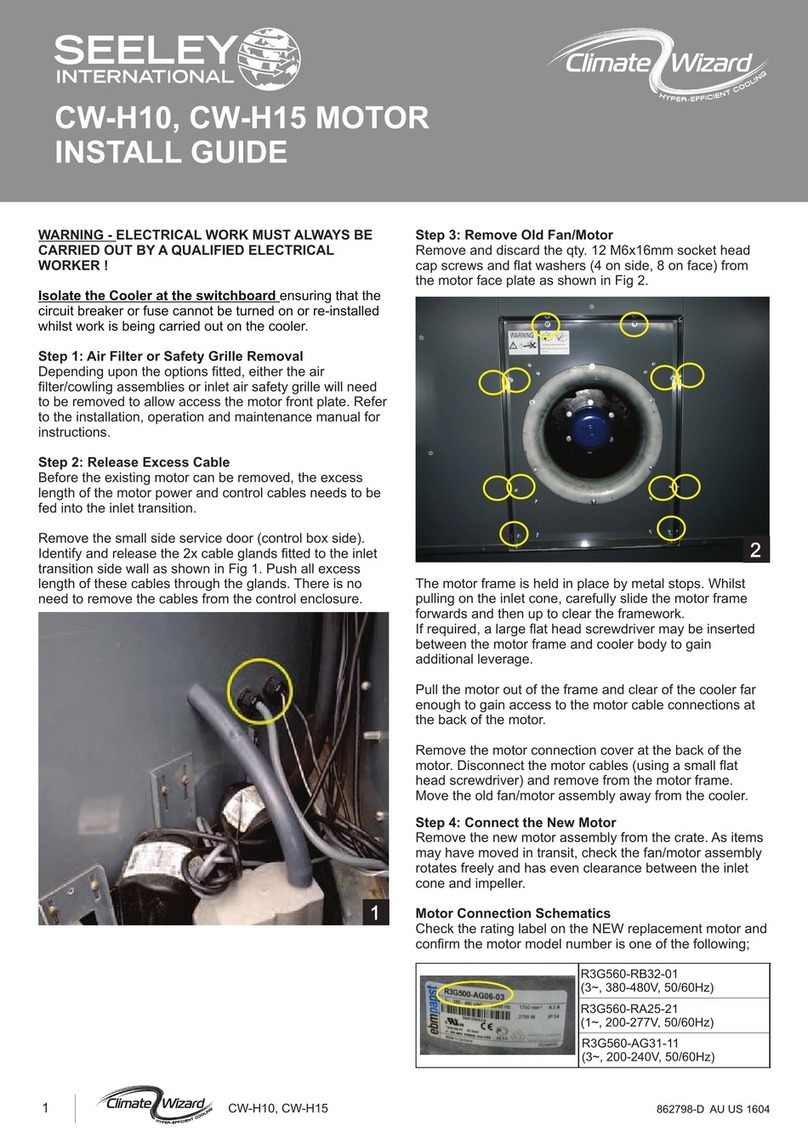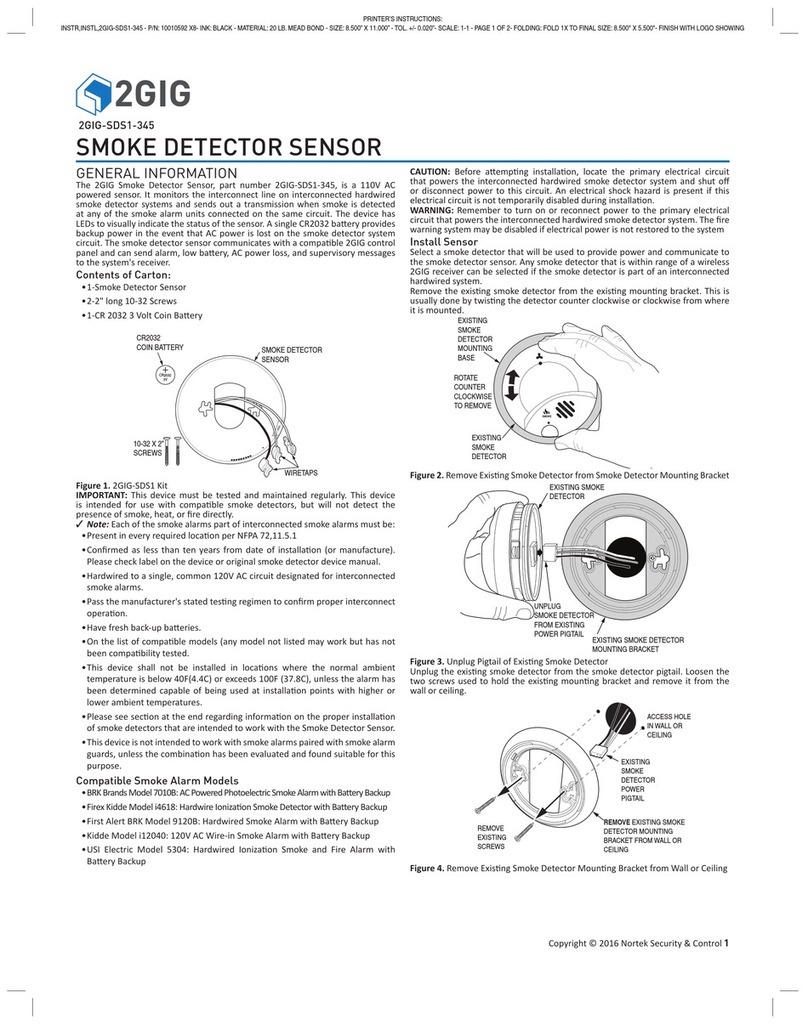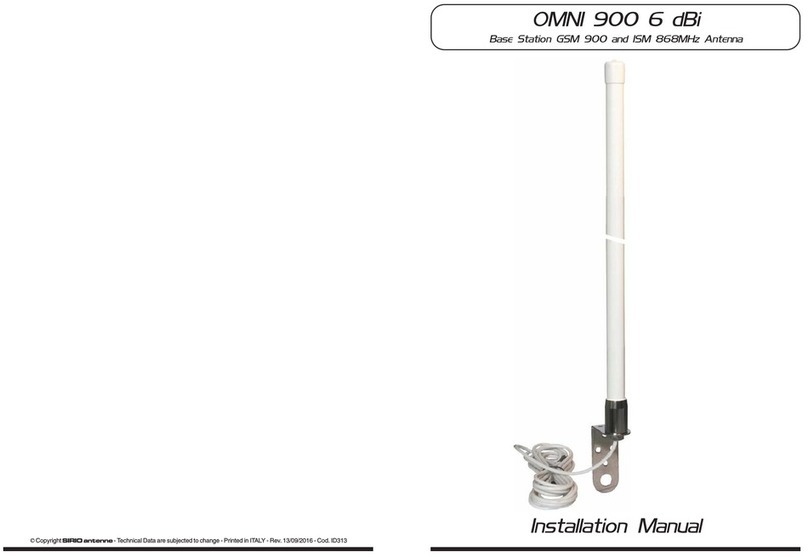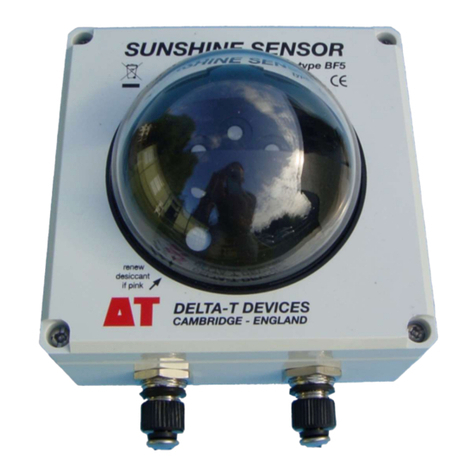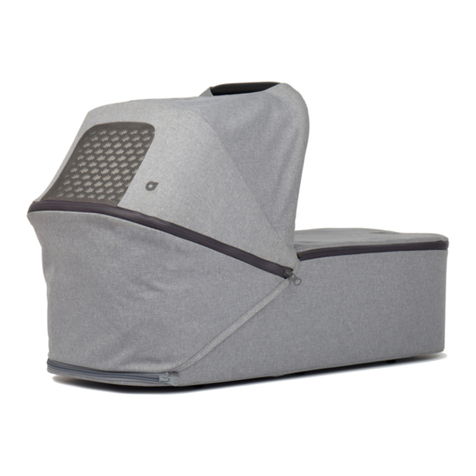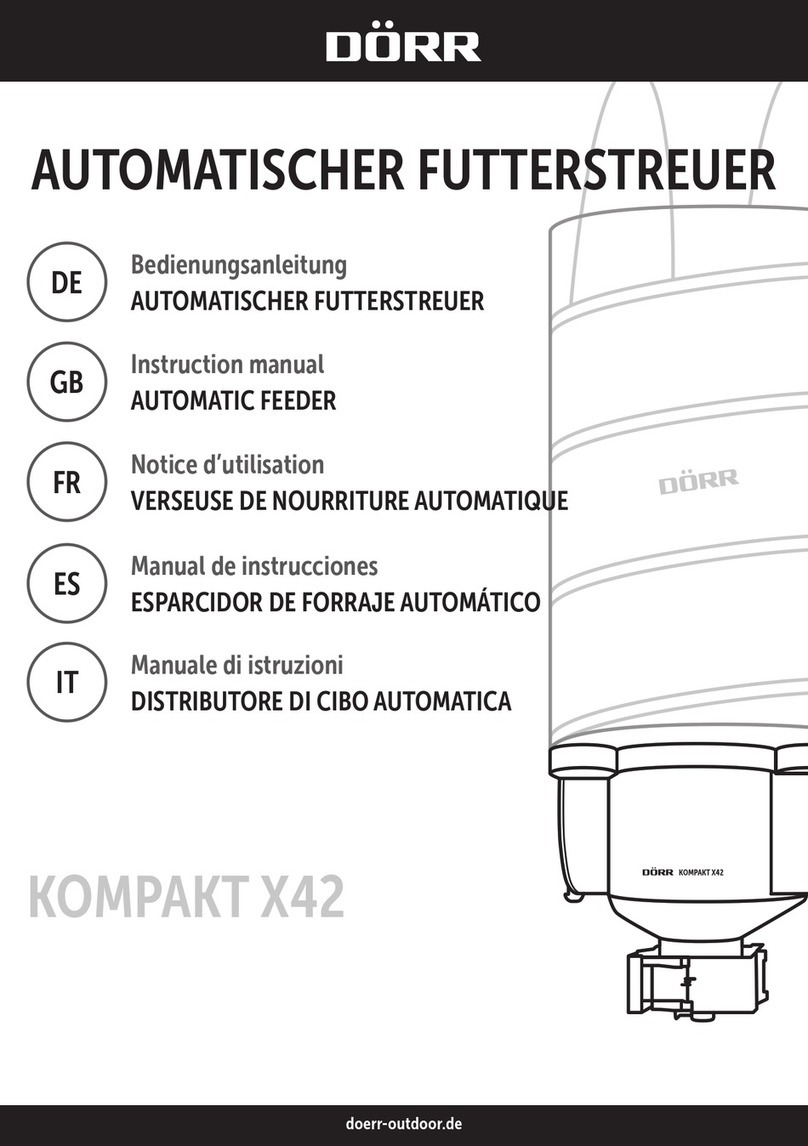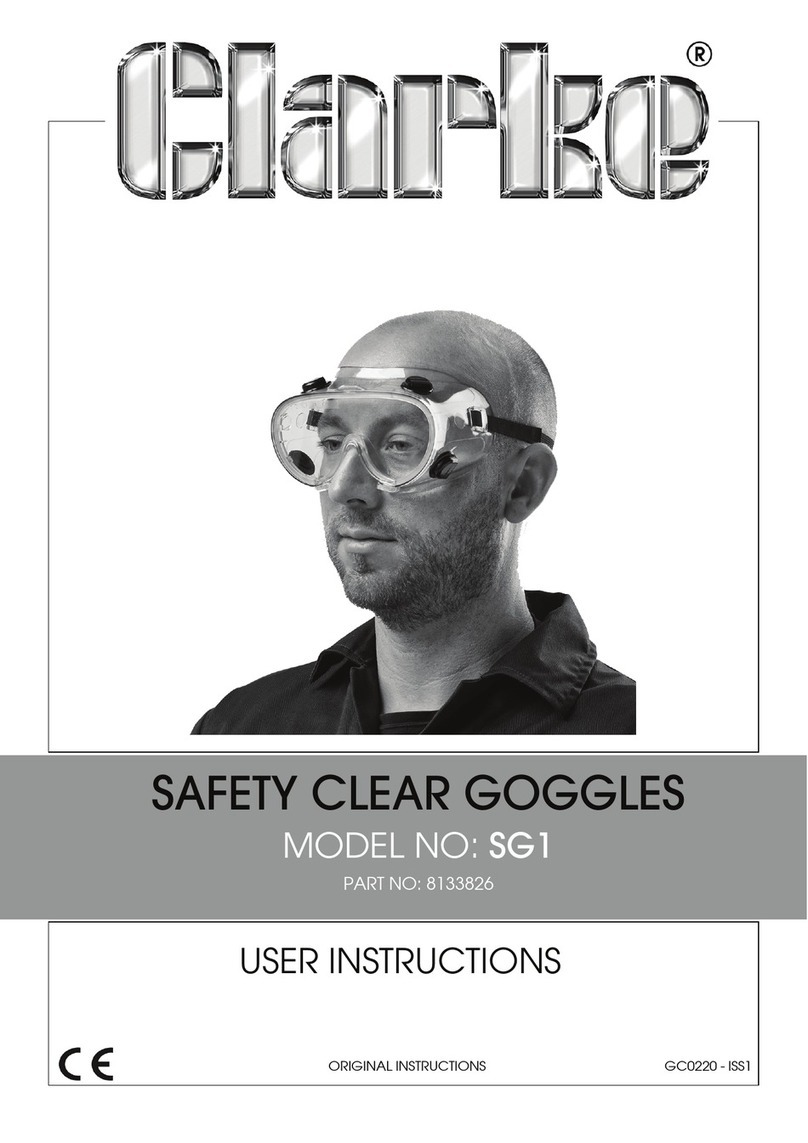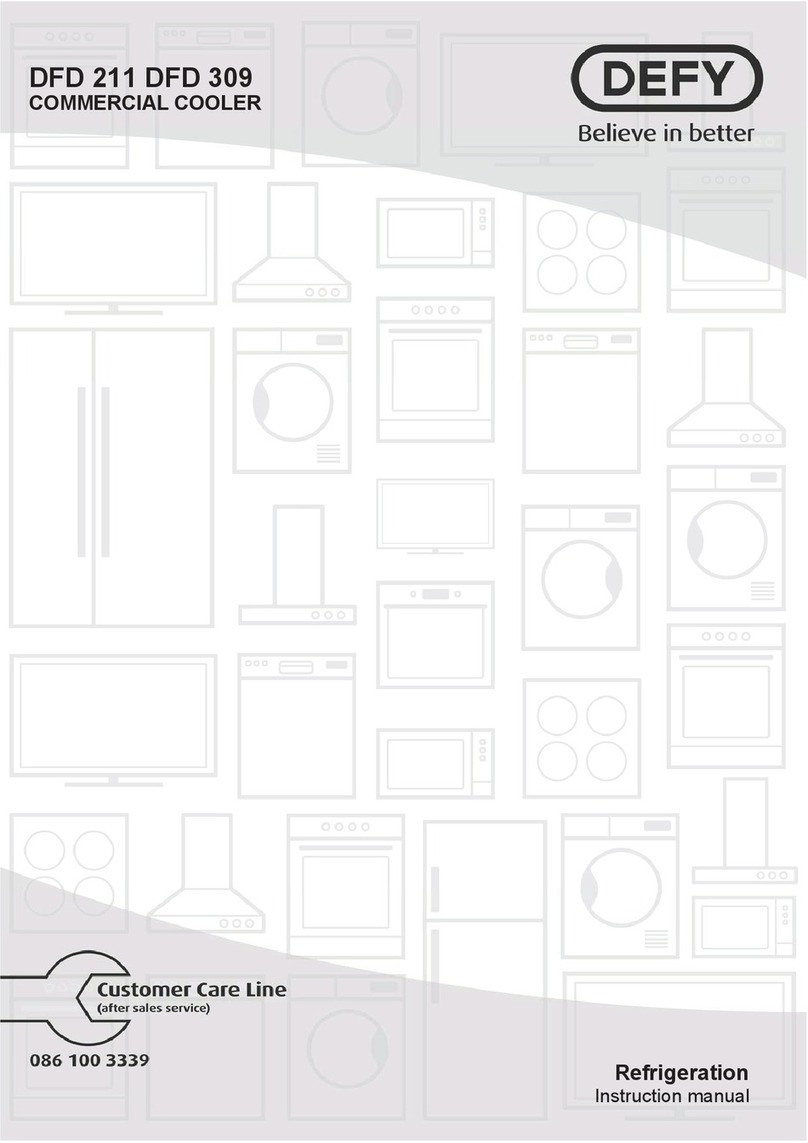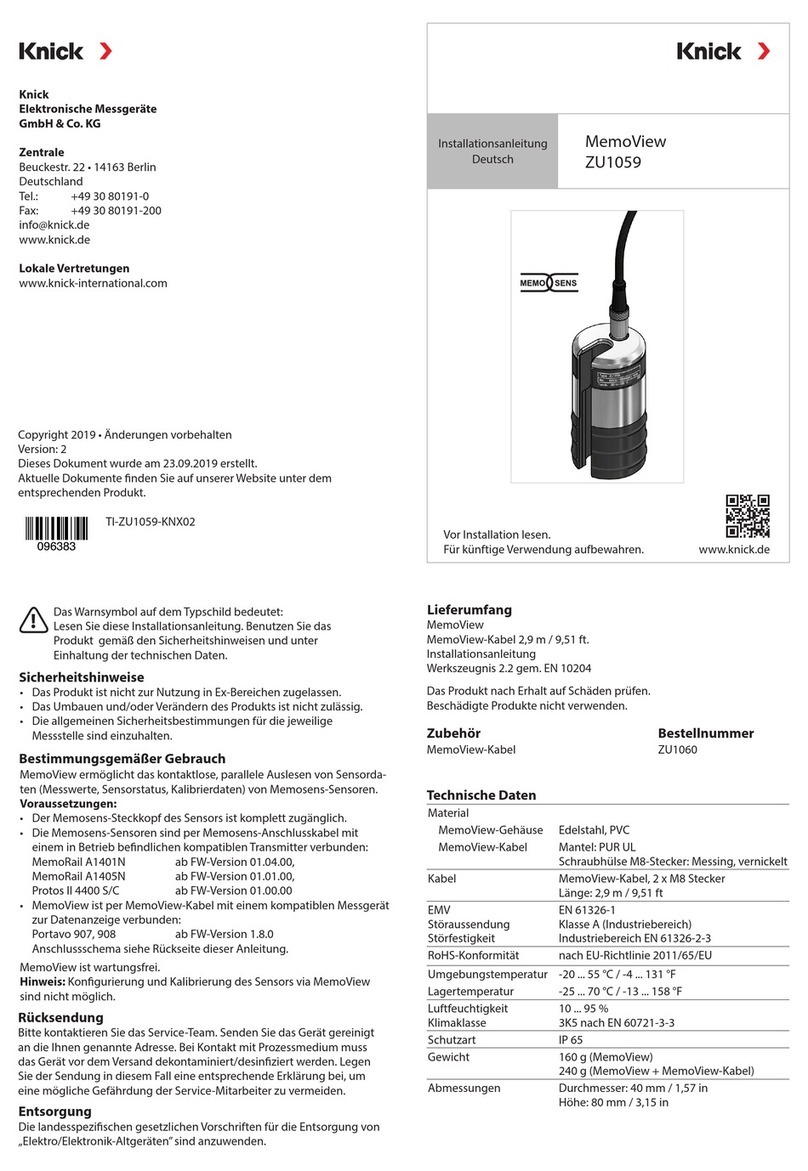Meech A70025 User manual

1
Cabinet Cooler &
Cabinet Cooler System
Operating
Manual


3
Products shown in this document may be covered by one or more patents, patents applied for
and/or registered designs and/or trade marks. For further information please refer to our Head
Ofce or visit www.meech.com.
© Meech Static Eliminators Ltd.
Contents
Section Page
1. Introduction 5
2. Safety and Inspection 6
3. Maintenance 7
4. Compressed Air Supply 9
5. Compressed Air Line Sizes 10
6. Installation 14
7. Operation 17
8. Solenoid Valve and Thermostat (Cabinet Cooler System Only) 20
9. Approvals 22
10. Troubleshooting 23


5
1. Introduction
The Meech Air Technology Stainless Steel Cabinet Cooler uses compressed air
to provide a cold air source which stops industrial cabinet/panels or enclosures
overheating and prevents ingress of contamination such as dust or moisture.
The Cabinet Cooler Unit (excluding Solenoid Valve and Thermostat) is intrinsically
safe, and requires virtually no maintenance. They have no moving parts making them
ideal for harsh environments.
Cabinet Coolers can be used with or without electrical thermostats and solenoid
valves (Cabinet Cooler System). These are used to regulate the cooling within an
enclosure.
This operating manual covers products:
A70025 - Cabinet Cooler Control Unit
A70325-24V – Cabinet Cooler System 24V
A70325-240V – Cabinet Cooler System 240V
A70325-110V – Cabinet Cooler System 110V

6
2. Safety and Inspection
Meech Cabinet Coolers are packed carefully at our factory. Nevertheless, we
recommend careful examination of the carton and contents for any damage.
To protect yourself and others when using compressed air, you should be aware of the
following general safety guidelines:
Warning – When compressed air is misused, it can cause serious injury or
even death.
Never point an air hose at anyone in fun or to remove dirt from clothing or the
body.
Never use compressed air without adequate eye and ear protection. Use
safety glasses with side shields or goggles and ear protectors.
Before attempting to disconnect a hose from an air line, the air should be cut
off, and the remaining air bled from the line.
Keep air hoses off the oor where they become tripping hazards and are
subject to damage by vehicles, doors, and dropped tools. If possible, suspend air
hoses from overhead.
Please be aware of the following safety guidelines specic to the Cabinet Cooler:
Cabinet Coolers create both hot and cold air so parts of the unit will become hot.
Do not operate the Cabinet Cooler at compressed air pressures above 11 Bar
(160 psi)
Compressed air temperature must not exceed 55°C
Ambient operating temperature must not exceed 66°C
Ambient operating temperature can not drop lower than -10°C

7
3. Maintenance
The Meech Cabinet Cooler has no moving parts. Clean compressed air moving
through the Cabinet Cooler will not cause wear on any of the components.
Occasionally, dirt, water or oil may enter the cooler from the compressed air supply.
This could hinder the performance. If this happens simply take the unit apart, clean
the parts with soapy water, allow drying time and then reassemble.
When reassembling ensure you tighten all the components. If the parts are not
tightened correctly, the coolers performance may be affected. Also, please ensure the
generator is tted. At the same time the element in the air lter should be changed.

8
1
1
2
2
3
3
4
4
5
5
6
6
A A
B B
C C
D D
MATERIAL:
DIMENSIONS
MM
DO NOT SCALE
TITLE:
DRAWING No:
PARTS LIST
REVPART NUMBERQTYITEM
BD50382 - Spin Chamber11
AGenerators (See Drawing)12
AD50032 - Bulkhead Fitting13
AD50056 - Hot End Cap14
BD50061 - Hot End Sleeve15
BD50083 - Needle Valve16
A
D50380 - Brass Sleeve
17
AD50088 - Silencer Spring18
AD50040 - Silencer Foam19
AD50094 - Plastic Insert110
D50153 - Star Washer
111
AD50036 - Bulk Head Washer112
BD50033 - Bulkhead Nut 33mm113
AD50075 - O Ring 17x3mm117
AD50076 - O Ring 3/8x1/4118
A
D50034 - O Ring 30x3mm
119
F00001 - Blind Rivet 3.2 x
4.8mm
120
A
D50035 - Relief Valve
121
A
D50081 - Red End Cap
122
AD50381 - Bulk Head Insert123
A
D50074 - O Ring316
4
5
1
7
2
3
6
8,82 [224.09 mm]
1,85 [47.03 mm]
1,89 [48 mm]
Exploded
View
16
18
10
9
8
12
13
3
16
16
17
11
22
21
7,75 [196.75 mm]
23

9
4. Compressed Air Supply
It is recommended to use a 5-micron (or smaller) lter to remove water and dirt from
the compressed air supply. A 5-micron lter will remove 99% of foreign material from
the air supply; the use of an oil lter with an effective ltration of 0.01 ppm will remove
the oil droplets for an even cleaner compressed air supply.
Failure to use a lter may cause clogging and freezing of the compressed air line and
the components within the Cabinet Cooler.
When the temperature of the compressed air within the Cabinet Cooler reaches 0°C
the water vapour in the air will start to freeze. This could potentially cause a problem
with ice clogging the orices of the Cabinet Cooler.
In this instance an air dryer must be used to lower the dew point and keep water
vapour out of the air line. A dryer rated at -19°C will produce a dew point low enough
to eliminate the water vapour freezing.

10
5. Compressed Air Lines Sizes
Figuring the correct pipe size for your compressed air system is an important task.
Pipe that is sized too small can create big pressure losses and reduce operating
efciency.
Many people who plan the piping never consider the ttings or the future.
FITTINGS: Every pipe tting creates a certain amount of increased frictional air loss
that is equal to a specied length of pipe. Any turns in the pipe at ttings, ells, tees,
and valves increase pressure drops even more.
FUTURE: Are you planning to add more equipment in the next year or two? Then
plan for larger piping now. Since the material costs in piping are low compared to
installation or replacement cost, it’s wise to select pipe of an adequate size. If there
is any doubt that a pipe size may create a pressure drop, use the next largest size.
Remember that an oversize pipe compensates for possible scale build-up and
provides for future expansion of the overall air system.
Steps to calculating overall piping size for your compressed
air system:
1. Determine your air compressor’s maximum CFM.
2. Draw a piping schematic and show all pipe ttings, valves, etc.
3. Measure and write the corresponding lengths of pipe on your schematic, then
total the length of all straight pipes needed and note that on your schematic.
4. Using TABLE 1 (over page), nd your compressor’s CFM number on the far left
column, and then go to the right until you see the column header with nearest
length in feet to your total pipe length. Find where the CFM & PIPE LENGTH
intersect on the chart and it will show the recommended pipe size for that length.
5. Take that pipe size to TABLE 2 and use the table to nd all the EQUIVELENT

11
LENGTHS OF PIPE needed for each PIPE FITTING. Write these lengths on
your piping schematic at each tting.
6. TOTAL all the EQUIVELENT LENGTHS OF PIPE needed for each PIPE FITTING
and add to your total of straight length of pipe. This will give you a new and more
accurate total pipe length needed.
7. Take your new total of EQUIVELENT LENGTH OF PIPE IN FEET back to TABLE
1 and use this number to determine the PIPE SIZE you need.
Specic Cabinet Cooler Pipe Size
To obtain maximum performance from the Cabinet Cooler, accurate measures of air
pressure and air volume must be obtained. Line pressure of 70-90 psi (5-6 Bar) can be
present without a sufcient volume (cfm) of air.
To ensure that both pressure and volume are present to efciently operate the Cabinet
Cooler a line size of 3/8” pipe or ½” hose should be used for applications 10ft from the
main header. Use ½” pipe or ¾” hose up to 20ft. For pipe size over 20ft from he header
please refer to section 5.

12
How to determine what size of PIPE you need for
compressed air lines:
TABLE 1: EQUIVALENT LENGTH OF PIPE LINES IN FEET
Don’t forget to include *PIPE FITTINGS in your final calculations
Your Air
Compressor’s
CFM
25
feet
50
feet
75
feet 100 feet 150 feet 200 feet 250 feet 300 feet
1 ½ ½ ½ ½ ½ ½ ½ ½
2 ½ ½ ½ ½ ½ ½ ½ ½
3 ½ ½ ½ ½ ½ ½ ½ ½
5 ½ ½ ½ ½ ½ ½ ½ ½
10 ½ ½ ½ ¾ ¾ ¾ ¾ ¾
15 ½ ¾ ¾ ¾ ¾ ¾ ¾ ¾
20 ¾ ¾ ¾ ¾ ¾ ¾ ¾ ¾
25 ¾ ¾ ¾ ¾ ¾ 1 1 1
30 ¾ ¾ ¾ ¾ 1 1 1 1
35 ¾ ¾ 1 1 1 1 1 1
40 ¾ 1 1 1 1 1 1 1
50 1 1 1 1 1 1 1 1
60 1 1 1 1 1 - 1/4 1 - 1/4 1 - 1/4 1 - 1/4
70 1 1 1 1 1 - 1/4 1 - 1/4 1 - 1/4 1 - 1/4
80 1 - 1/4 1 - 1/4 1 - 1/4 1 - 1/4 1 - 1/2 1 - 1/2 1 - 1/2 1 - 1/2
100 1 - 1/4 1 - 1/4 1 - 1/4 1 - 1/4 1 - 1/2 1 - 1/2 1 - 1/2 1 - 1/2
125 1 - 1/4 1 - 1/4 1 - 1/4 1 - 1/4 1 - 1/2 1 - 1/2 1 - 1/2 1 - 1/2
150 1 - 1/4 1 - 1/4 1 - 1/4 1 - 1/4 1 - 1/2 1 - 1/2 1 - 1/2 1 - 1/2
175 1 - 1/2 1 - 1/2 1 - 1/2 1 - 1/2 2 2 2 2
200 1 - 1/2 1 - 1/2 1 - 1/2 1 - 1/2 2 2 2 2
225 1 - 1/2 1 - 1/2 1 - 1/2 1 - 1/2 2 2 2 2
250 2 2 2 2 2 2 2 2
275 2 2 2 2 2 2 2 - 1/2 2 - 1/2
300 2 2 2 2 2 2 2 - 1/2 2 - 1/2
350 2 2 2 2 2 - 1/2 2 - 1/2 2 - 1/2 2 - 1/2
400 2 2 2 2 2 - 1/2 2 - 1/2 2 - 1/2 2 - 1/2
450 2 - 1/2 2 - 1/2 2 - 1/2 2 - 1/2 2 - 1/2 2 - 1/2 3 3
500 2 - 1/2 2 - 1/2 2 - 1/2 2 - 1/2 2 - 1/2 2 - 1/2 3 3
550 2 - 1/2 2 - 1/2 2 - 1/2 2 - 1/2 3 3 3 3
600 2 - 1/2 2 - 1/2 2 - 1/2 2 - 1/2 3 3 3 3
750 2 - 1/2 2 - 1/2 2 - 1/2 3 3 3 3 4
1000 3 3 3 3 3 3 4 4
TABLE 2: * EQUIVALENT LENGTH OF PIPE (FT.) for PIPE FITTINGS
Add these numbers for each pipe fitting to total length of straight pipe
Pipe
Size
Long Rad, Ell or
run of tee
STD. Ell or Run of
reduced tee
Tee Thru
side outlet Globe Valve Gate Valve
½ 0.62 1.55 3.1 17.3 0.36
¾ 0.82 2.06 4.12 22.9 0.48
1 1.05 2.62 5.24 29.1 0.61
1 - 1/4 1.38 3.45 6.9 38.3 0.81
1 - 1/2 1.61 4.02 8.04 44.7 0.94
2 2.07 5.17 10.3 57.4 1.21
2 - 1/2 2.47 6.16 12.3 68.5 1.44
3 3.07 6.16 15.3 85.2 1.79
4 4.03 7.67 20.2 112 2.35

13
6. Installation
The drawing below shows the recommended way to t a Meech Cabinet Cooler and
Cabinet Cooler System (including digital thermostat and solenoid valve).
Solenoid
Valve
Cabinet Wall
Ducting
Filter
240v/110v/24v
Thermocouple
Digital
Thermostat
Air Inlet Cabinet Cooler
To t the Cabinet Cooler follow the steps below:
A. Drill Hole
Drill 1.02” (26 mm) hole in the position you would like to t the Cabinet Cooler.
Please be aware that 200mm of the Cabinet Cooler will extend from the outside of
the enclosure so allow clearance.
It’s recommended that the Cabinet Cooler is installed in the top of the enclosure.
However, if space is an issue the Cabinet Cooler can be installed in any position, even
upside down, with no loss of performance.

14
B. Remove bulk head nut & washer from the bottom of the
Cabinet Cooler
C. Fit desired generator
As standard the Cabinet Cooler is supplied with a red (Refrig) 15cfm, 293W (1000
Btu/hr) generator. To change the generator simply unscrew the bulk head tting and
replace the generator with another colour. Please remember to re-t the o-ring and
screw bulk head tting until tight.
Four generators are provided with the Meech Cabinet Cooler. Information on all
generators and sizing can be found in section 7.

15
D. Fit Cabinet Cooler in place
From outside the enclosure, place the cold end of the Cabinet Cooler into the drilled
hole.
E. Re-t bulk head nut and washer
Once this is done tighten bulk head nut & washer until the Cabinet Cooler is secure.
F. Connect cold air ducting to the end.
It’s recommended that the cold air ducting is directed from the cabinet cooler to the
bottom of the enclosure. This will allow for increased cooling throughout the cabinet/
panel. This will also avoid any excess water vapour in the compressed air being blown
over components.
If the air is clean and dry the cold air ducting can be directed to particularly hot areas
of the enclosure. Alternatively you can drill holes in the cold air ducting and allow air
to be distributed to several areas. If you choose this method you will need to plug the
end of the cold air ducting and ensure the holes drilled into the tube are equal to the
hole at the end.
Where necessary please t appropriate lters.
G. Connect air supply
The Cabinet Cooler has a ¼” bsp female air inlet. Standard pneumatic push-t
compressed air ttings can be used on the Cabinet Cooler.
Please refer to section 5 when deciding on pipe sizes.
H. Connect the digital thermostat & solenoid valve to the air
supply (only with Cabinet Cooler System)
See section 8 of this operating manual
Your Cabinet Cooler is now ready for use.

16
7. Operation
1. Cabinet Cooler
The Cabinet Cooler is factory set to deliver the most efcient cooling needed to
maintain a desired temperature inside an enclosure.
At 80psi (5.5 Bar), 10cfm (70% of 15 cfm, red generator) of cold air will exit from the
Cabinet Cooler providing 293 Watts (1,000 Btu) of Cooling.
The bladder valve acts as a pressure relief valve. This will automatically release air
from the enclosure maintaining approximately 8” water column (0.0199 Bar) positive
pressure inside the cabinet/panel.
2. Generators
The generators within the Cabinet Cooler control the air consumption and air ow. They
also inuence the achievable temperatures.
The chart below shows achievable temperatures with different generators tted.
Please note these are approximate temperatures and should only be used as a guide.
The Cabinet Cooler will perform differently when used in other environments.
Inlet air pressure
Product
Code
Generator
Colour
Consumption
in CFM (l/min)
60 PSI (4.1 Bar) 80 PSI (5.5 Bar) 100 PSI (6.8 Bar)
CFM at
test
2.5 turns of
needle valve
CFM at
test
2.5 turns of
needle valve
CFM at
test
2.5 turns of
needle valve
cfm (l/min) °C cfm (l/min) °C cfm (l/min) °C
A21008 Green 8L (227) 15 (425) -23.4 19 (538) -30.1 21 (595) -33.4
A20008 Yellow 8H (227) 13 (368) -24.2 18 (510) -28.5 20 (566) -31.7
A21010 Green 10L (283) 15 (425) -26.9 19 (538) -35.5 21 (595) -36.0
A20010 Yellow 10H (283) 13 (368) -27.2 18 (510) -35.0 21 (595) -31.3
A21015 15L (425) 17 (481) -29.8 22 (623) -34.2 25 (708) -35.4
A20015 Red 15H (425) 16 (453) -28.3 21 (595) -32.9 25 (708) -32.6
A21025 Grey 25L (708) 23 (651) -23.3 28 (793) -23.7 30 (849) -25.7
A20025 Blue 25H (708) 23 (651) -19.0 30 (849) -23.4 31 (878) -24.9
A21035 Beige 35L (991) 27 (765) -16.7 34 (963) -16.5 39 (1104) -18.6
A20035 Brown 35H (991) 30 (849) -15.8 36 (1019) -18.6 43 (1218) -18.0

17
The graph below shows air consumption at varying inlet air pressures.
Inlet Air Pressure (psi)
Air Consumption (cfm)
0
5
10
15
20
25
30
35
40
A20035,
A24036
A20025,
A24026
A20015,
A24016
A20010, A2401
1
A20008,
A21008
10080604020
4 x High fraction generators are supplied as standard:
Yellow 10cfm (283 l/min) - Cooling capacity of 190W (650 Btu/hr)
Red 15cfm (425 l/min) – Cooling capacity of 293W (1000 Btu/hr)
Blue 25cfm (708 l/min) – Cooling capacity of 499W (1,700 Btu/hr)
Brown 35cfm (991 l/min) – Cooling capacity of 703W (2,400 Btu/hr)
A single Meech Cabinet Cooler is capable of cooling up to 703 Watts (2,400 Btu/hr).
Optimising the cooling capacity is still a vitally important factor, choosing the correct
generator will not only reduce running costs but also extend the life of the compressor.
To choose the most efcient generator you must calculate the total heat load in Watts
Btu/hr to which the enclosure is exposed. The total heat load is a combination of
the heat transfer from outside due to ambient air temperature and the heat which is
created internally.
For more information on calculating test loads refer to the Meech Air Technology
brochure, available to download from www.meech.com.

18
3. Humidity
If a cabinet cooler is run constantly relative humidity inside the cabinet stabilises at
approximately 45%.
To prevent condensation forming on the cold air pipe close off any vents or fan outlets
on the outside wall of the enclosure. This reduces the ambient air from circulating
within the cabinet/panel and reduces the chance of condensation.
Fans can be installed into the enclosure which will help to circulate air.

19
8. Solenoid Valve & Thermostat (Cabinet
Cooler System Only)
A Cabinet Cooler System is supplied with either a 24V, 110V or 240V digital
thermostat and solenoid valve.
The combination of solenoid valve and digital thermostat allows application specic set
up and reduces running costs. It means cold air will only be supplied to the enclosure
when it’s needed.
The digital thermostat is factory set to activate the cabinet cooler when the internal
cabinet/panel temperature reaches 30°C. It will then cool the enclosure until the
temperature drops to 22°C. At this point the Cabinet Cooler is deactivated ready for
the process to start again.
Adjustment of Meech Factory settings
The thermostat is password protected to stop adjustment of the parameters. The
following 3 steps explain how to unlock the thermostat for parameter adjustment.
1. Power up thermostat – the temperature will be displayed.
2. Press and hold the ‘P’ until a ‘0’ is displayed (when 0 is displayed release the
‘P’ button)
3. Press and hold the ˄ button until the display shows 9000. Press ‘P’ once, you
will now have access to change the parameters.
Adjusting the main parameters
There are 2 main parameters that you may wish to adjust; the Set Point and
Differential. The following 5 steps will guide you though this process.
1. Use the 2 arrow buttons to toggle through the parameters.
2. When you reach ‘SP’ on the display stop and press the ‘P’ button once. This
allows you to adjust the set point of the thermostat between 10 and 50. The Set

20
Point is the temperature that once activated the system will cool the cabinet/panel
to (factory set to 22°C).
3. Once you have entered your Set Point press the ‘P’ button once. This will
activate the new setting and return you to the main toggle menu.
4. Using the 2 arrow buttons toggle through the parameters until you reach ‘HSEt’.
5. When you have reached ‘HSEt’ press the ‘P’ button once. This allows you
to adjust the differential of cooling. The differential is the number of degrees
above the set point that the unit will cool from (factory set to 8°C above a set
point of 22°C, meaning the unit will start cooling when the internal cabinet
temperature reaches 30°C).
This manual suits for next models
4
Table of contents
Other Meech Accessories manuals
